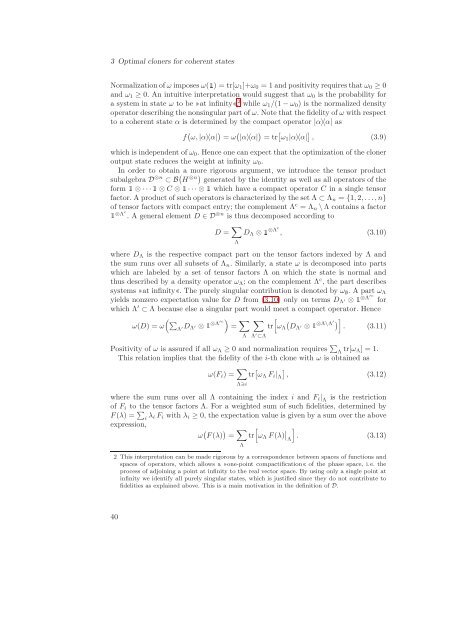Quantum Information Theory with Gaussian Systems
Quantum Information Theory with Gaussian Systems
Quantum Information Theory with Gaussian Systems
Create successful ePaper yourself
Turn your PDF publications into a flip-book with our unique Google optimized e-Paper software.
3 Optimal cloners for coherent states<br />
Normalization of ω imposes ω( ) = tr[ω1]+ω0 = 1 and positivity requires that ω0 ≥ 0<br />
and ω1 ≥ 0. An intuitive interpretation would suggest that ω0 is the probability for<br />
a system in state ω to beat infinity, 2 while ω1/(1 − ω0) is the normalized density<br />
operator describing the nonsingular part of ω. Note that the fidelity of ω <strong>with</strong> respect<br />
to a coherent state α is determined by the compact operator |α〉〈α| as<br />
f ω, |α〉〈α| = ω |α〉〈α| = tr ω1|α〉〈α| , (3.9)<br />
which is independent of ω0. Hence one can expect that the optimization of the cloner<br />
output state reduces the weight at infinity ω0.<br />
In order to obtain a more rigorous argument, we introduce the tensor product<br />
subalgebra D⊗n ⊂ B H⊗n generated by the identity as well as all operators of the<br />
form ⊗ · · · ⊗ C ⊗ · · · ⊗ which have a compact operator C in a single tensor<br />
factor. A product of such operators is characterized by the set Λ ⊂ Λn = {1, 2, . . ., n}<br />
of tensor factors <strong>with</strong> compact entry; the complement Λc = Λn \ Λ contains a factor<br />
⊗Λ c<br />
. A general element D ∈ D⊗n is thus decomposed according to<br />
D = <br />
Λ<br />
DΛ ⊗ ⊗Λc<br />
, (3.10)<br />
where DΛ is the respective compact part on the tensor factors indexed by Λ and<br />
the sum runs over all subsets of Λn. Similarly, a state ω is decomposed into parts<br />
which are labeled by a set of tensor factors Λ on which the state is normal and<br />
thus described by a density operator ωΛ; on the complement Λc , the part describes<br />
systemsat infinity. The purely singular contribution is denoted by ω∅. A part ωΛ<br />
⊗Λ′c<br />
yields nonzero expectation value for D from (3.10) only on terms DΛ ′ ⊗ for<br />
which Λ ′ ⊂ Λ because else a singular part would meet a compact operator. Hence<br />
ω(D) = ω Λ ′DΛ ′ ⊗<br />
⊗Λ′c<br />
= <br />
tr ωΛ DΛ ′ ⊗<br />
⊗Λ\Λ′<br />
. (3.11)<br />
Λ<br />
Λ ′ ⊂Λ<br />
Positivity of ω is assured if all ωΛ ≥ 0 and normalization requires <br />
Λ tr[ωΛ] = 1.<br />
This relation implies that the fidelity of the i-th clone <strong>with</strong> ω is obtained as<br />
ω(Fi) = <br />
tr <br />
ωΛ Fi| Λ , (3.12)<br />
Λ∋i<br />
where the sum runs over all Λ containing the index i and Fi| Λ is the restriction<br />
of Fi to the tensor factors Λ. For a weighted sum of such fidelities, determined by<br />
F(λ) = <br />
i λi Fi <strong>with</strong> λi ≥ 0, the expectation value is given by a sum over the above<br />
expression,<br />
ω F(λ) = <br />
tr ωΛ F(λ) <br />
. (3.13)<br />
Λ<br />
Λ<br />
2 This interpretation can be made rigorous by a correspondence between spaces of functions and<br />
spaces of operators, which allows aone-point compactificationof the phase space, i.e. the<br />
process of adjoining a point at infinity to the real vector space. By using only a single point at<br />
infinity we identify all purely singular states, which is justified since they do not contribute to<br />
fidelities as explained above. This is a main motivation in the definition of D.<br />
40
















